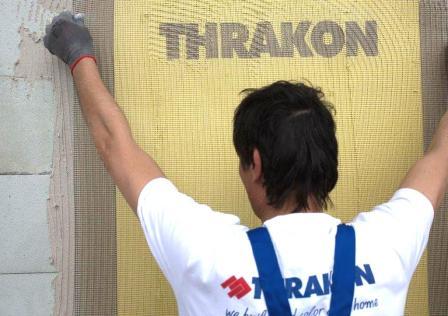
Plâtre de surfaces absorbantes (par exemple, la maçonnerie YTONG)

What do we need?Aerated concrete, e.g. YTONG masonry, because of a considerably shorter time required for their manufacture but also because of its particularly planar final surface giving compared to traditional brick, requires a plaster system much smaller thickness than the thickness of the traditional system (which is an average of 3-4cm), but also a system that is applied in a very short time and is quite economical to exploit the advantages offered by aerated concrete masonry (speed-economy-smaller plaster thicknesses).How do we do it?Aerated concrete masonry will be plastered with Fiber reinforced -Elastic plastering system of THRAKON which requires small implementation time and gives an excellent finish in a range of colors and styles for the manufacturer, without the need for paint.Products usedGLX 290THC 409THC 410DEC 428 PolyplastDEC 431 FineDEC 429 SilicateDEC 438 SiliconeGLX 494 Prim CLIMAPLUS MeshCLIMAPLUS Waterdrop profilePlastic corner beadStep by stepClean the outer surface of decayed or other contaminants and remove any lumps of mud and plaster. Where necessary make the appropriate repairs to the masonry.Prime surfaces of concrete and YTONG masonry with acrylic primer GLX 290 diluted at a ratio GLX 290 to water = 1: 4. After 2 to 6 hours depending on atmospheric conditions apply the fiber reinforced -elastic plastering systems of THRAKON. Reinforce the corners of windows and doors, and all angles and openings using plastic staff corner bead THRAKON before applying the base layer of the coating. Around windows and doors further assistance is required with ClimaPLUS grid dimensions 30 x 20 cm. The mesh applied diagonally. For the transition from vertical to horizontal surfaces, eg windows, we recommend using waterdrop profile ClimaPLUS. Apply a layer of coating THC 409 or THC 410 thickness 5mm and while still wet place the reinforcement fiberglass mesh, taking care that it bridges the plates connections. On the edges of the walls should not be cut, but covers them. Press with spatula the grid to incorporate in the coating layer, add another thin coating layer and smoothed with a spatula to achieve a final flat surface. After 7 days prime crosswise the plastered surface with the acrylic primer GLX 494 which should be colored in the hue of the final coating.Then apply one of the following final decorative coating (see. Decoration of surfaces with organic coatings):DEC 428 Polyplast – Colored acrylic coating (style RILLEN or SCRATCH)DEC 431 Fine – Colored acrylic coating – smooth finishDEC 429 Silicate – Silicate coloured coating (style RILLEN or SCRATCH)DEC 438 Silicone – Coloured silicone coating (style RILLEN or SCRATCH) The choice of decorative coating made according to the desired texture of the final surface and the demands of manufacturing (see. Table of Decorative Coatings).The organic coatings surface THRAKON’s type DEC available in different styles and can be colored in various shades via the tinting system of THRAKON. The available shades are 200 and indicated by THRAKON fan bearing the appropriate code. For the selection of shades suggest using lightest coating (brightness> 20). Dark colors absorb more intense solar radiation risk cracks due to expansion and contraction of stronger growth. The fan THRAKON’s beside the code of each color indicating the luminance factor. For dark shades preferred to use a gray adhesive and for bright colors white. Application of organic topcoat: first spread on the surface and then the excess material is removed so that the thickness of the layer corresponds to the grain size.Depending on the style of the coating, use stainless steel or plastic spatula. The Rillen type coatings and Scratch be applied with a plastic spatula to properly achieve the desired style and avoid any discoloration of the final surface. The application process requires coordinated the workshop mode of the method to be followed « wet-on-wet » without interruption in continuous surfaces. Otherwise if first coat dries on the surface before and after apply fresh material on the surface following will be noticeable discolorations on splices. Therefore, it must ensure that enough artificial application at every point of the scaffolding and take into account the weather conditions because they affect the drying time of the material.Note: In cold weather and high humidity, drying time is lengthened while at high temperatures with low humidity the drying time is slowed.



